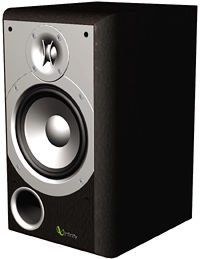| Columns Retired Columns & Blogs |
Infinity Primus 150 loudspeaker
It was 20 years ago that I began audio reviewing as a second career. It was also 20 years ago that I made my first very expensive audio purchase: a pair of Infinity RS-1b speakers. The RS-1b was a landmark speaker in its day, and very costly for the time at $5500/pair. (I think my dentist has just spent more than that on a TV.) In retrospect, the RS-1b was an extraordinary value. With four large towers, more than 30 drivers, and a servo network and a passive crossover, the Infinity RS-1b resolved a significant amount of detail, was capable of large dynamic swings, had pinpoint image specificity on a wide, deep soundstage, and was capable of reproducing a convincing bottom octave in the right room when paired with the right associated equipment. Its main weaknesses were a relative lack of coherence due to its use of three different types of drivers to cover the various frequency ranges, and both the midrange/tweeter towers and woofer columns were picky about amplifier matching.
 The RS-1bs served me for 10 years as both analytical reviewing tools and party tools for enjoying a wide range of music with friends. In fact, a number of friends got hooked on the audio hobby after hearing my Infinity system. (My original pair is still running happily at a friend's lake house outside Houston.) Furthermore, when used with modern electronics, the RS-1b still holds its own against current designs, and is a steal in today's used market. (Replacement drivers are no longer available, however.)
The RS-1bs served me for 10 years as both analytical reviewing tools and party tools for enjoying a wide range of music with friends. In fact, a number of friends got hooked on the audio hobby after hearing my Infinity system. (My original pair is still running happily at a friend's lake house outside Houston.) Furthermore, when used with modern electronics, the RS-1b still holds its own against current designs, and is a steal in today's used market. (Replacement drivers are no longer available, however.)
But I've never reviewed an Infinity speaker—their most interesting designs tended to be the more expensive ones, and my journalistic juices get bubbling on the opposite end of the price spectrum. That all changed in June 2003, when Infinity announced its entry-level Primus line.
The Primus Directive
Infinity's Primus line comprises five stereo speakers, which range from the $178/pair Primus 140 bookshelf to the $658/pair Primus 360 floorstander. The line also includes a center-channel home theater speaker and three powered subwoofers. Although each Primus model is designed to be used for full-range music playback, any of the stereo speakers in the Primus line can be matched (seamlessly, according to Infinity) with any of their powered subwoofers when additional bass extension is desired for a two-channel or home theater applications.
All Primus speakers share the same design philosophy, differing only in the number and size of their drivers. The series incorporates Infinity's proprietary Metal Matrix driver diaphragms. Infinity claims that this technique results in reduced distortion and cone breakup as well as improved transient response, resolution, and smoothness throughout each driver's range.
Infinity felt very strongly that the Primus 150, one notch up from the bottom of the line, should be the model reviewed; the 150 will be heavily promoted through such mass-market chains as Circuit City and Crutchfield, as well as through audiophile dealers. Their goal is to get grandma feeling comfortable about getting a hi-fi for her assisted-living condo without feeling intimidated by a high-end hi-fi salon.
The front-ported, two-way Primus 150 features a ¾" tweeter and a 5¼" woofer. Its rigidly braced cabinet also incorporates keyhole mounts to facilitate wall-mounting. As usual, I tested the speakers using Celestion Si stands. Infinity claims a slight improvement in transparency when the speakers are used with their grilles off (I agree). The 150s, finished in black ash, are also rather attractive sans grilles—their baffles are finished in a silver trim that matches the color of the drive-units.
To boldly go...
As I review my listening notes, I note that the Primus 150 excelled in three areas unusual for a $300/pair speaker of this size. Then I rechecked the press materials from Infinity and discovered that the 150 actually retails for $198/pair. I shook my head in amazement as I pondered:
1) The natural and uncolored midrange of the Primus 150 rendered all male and female vocals with a rich, natural, holographic sense of realism and body, without a trace of coloration. On classical and jazz recordings, woodwinds, pianos, and acoustic guitars were reproduced with natural attack and decay, with harmonics into the extended, natural, and airy high frequencies.
2) The levels of detail resolution and low-level dynamic articulation of the Primus 150 were unheard of for $200/pair. This attribute, combined with the Primuses' ability to disappear while reproducing well-recorded works on a wide, deep soundstage, may make the 150 the speaker for classical music aficionados who cherish the reproduction of concert-hall ambience. Moreover, the speaker is very useful as an analytical tool; I could analyze the articulation of a soloist's style as well as decipher multipart instrumental arrangements.
3) Although low- and mid-bass were inaudible with these speakers, the quality of the upper bass was reproduced with extraordinary clarity and authority.
- Log in or register to post comments




































